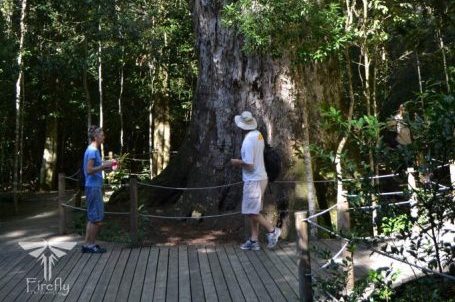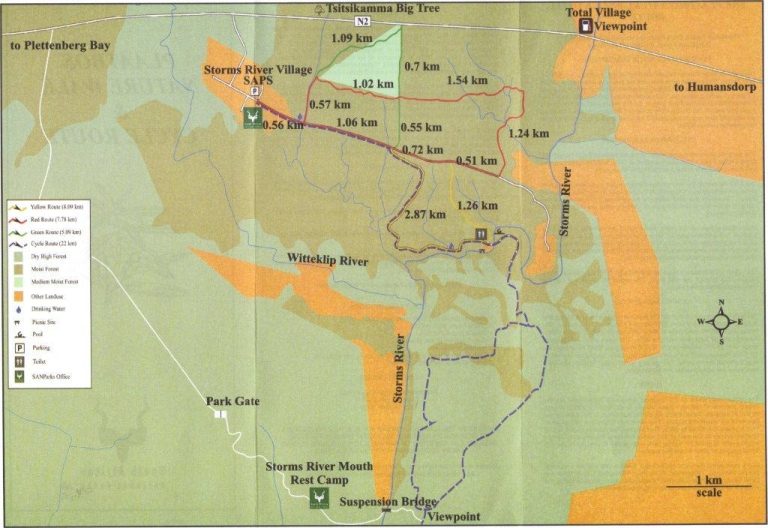
The Tsitsikamma Big Tree has been around for a while. Literally and figuratively. It’s not just one of the iconic Tsitsikamma attractions but also one of the most well-known on the Garden Route. The Big Tree is situated on the N2, just east of the entrance to Storms River Village. So why is this specific tree so significant? The tree is an indigenous Outeniqua Yellowwood, estimated to be about 1000 years old and a true giant of the forest.

Getting to the tree from the visitor center is a nice easy 500m walk along a wooden boardwalk through the indigenous forest. Walking to the tree takes about 10 minutes, but if you want to explore the forest a little bit more you can continue on the Ratel Nature Walk that continues from the tree. follows on from the Big Tree. This trail offers either a 2.6km or 4.2km walk through wet and medium moist high forest with both options being relatively easy.

Following the boardwalk, you shouldn’t just rush ahead to try and get to the tree as quickly as possible. I like to take it easy, listen to the birds and frogs, look for little flowers, mushrooms and fungi, and just take in the forest around me I once even got to see a chameleon.

At the end of the boardwalk you come face to face with the Big Tree. It stands 36.6 meters high and has a circumference of almost 9 meters. The canopy boasts a spread of 33 meters. At a thousand years old this tree was around when the KhoiSan were the only inhabitants of the region, when elephants migrated through the Tsitsikamma long before the first woodcutters and hunters came, when first Bartholomeu Dias, the first European to travel round the southern tip of Africa, and Portuguese explorer Vasco da Gama sailed along this coastline. It was here when Jan van Riebeeck landed at the Cape, Shaka Zulu founded the Zulu empire, the Boers left the Cape Colony on the ‘Great Trek’ and the Anglo Boer War took place. It saw the rise and fall of Apartheid and the beginning of the 21 Century. What I’m trying to say is, it is old.

The Binomical name of the Outeniqua Yellowwood is Afrocarpus falcatus. Afro = of Africa, and karpos = fruit (Greek); falcatus = sickle-shaped (Latin) alludes to the leaves. Outeniqua Yellowwood belongs to a conifer genus endemic to Africa. This tree occurs from the southern Western Cape, through the Eastern Cape and KwaZulu-Natal, and northwards to Mpumalanga and Limpopo and also eastwards to Mozambique.
The tree is either male or female. The male cones develop during early summer (November) on twigs produced the previous year and the pollen is released by the end of the next winter (a two-year period). The dry cones on the forest floor are indicative of male trees. The female cones develop with new leaves in spring and are pollinated when the pollen is released from the almost one-year-old male cones. The main agents of seed dispersal are fruit bats, which eat the fleshy covering but discard the hard, woody seed.

The wood is used extensively for furniture, roof beams, floorboards, door and window frames and boat building. Some of the famous yellowwood antiques seen throughout South Africa were made from the wood of this specific tree. The straight stems of these trees were once used for the topmasts of ships. It was for these reasons that much of the indigenous forests were cut down in the 1800s and early 1900s. Today the Yellowwood tree ise protected under the National Forests Act, 1998, as amended, and may not be cut, damaged, destroyed or disturbed without a license granted by the Department of Agriculture, Forestry & Fisheries.
I know all that was a mouthful, but now you don’t just know why the Big Tree is significant, but you also know a little more about the species.




